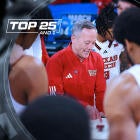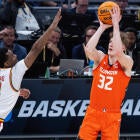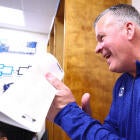What is the quadrant system? What exactly does non-conference strength of schedule consist of? Chances are if you watched last Bracket Preview show on CBS earlier this month, both of those questions ran through your head as committee chair Bruce Rasmussen explained why the current top 16 seeds landed where they did.
In projecting the NCAA Tournament field, the committee takes into account a number of different metrics – RPI and the quadrant system being the most talked about of late – but both have been scrutinized for their own unique flaws.
Rasmussen, in an article with the Omaha (Nebraska) World-Herald, defended both systems and explained why the committee uses them.
Non-conference SOS is not a predominant tool in selections.
"In fact, each year that I have been on the committee, we have discussed why you have to look beyond the number to evaluate a team's non-conference strength of schedule, and even with this qualifier, non-conference schedule ranks well behind other factors such as how you did against other tournament caliber teams, did you win the games you were supposed to win, and how did you do away from home since winning away from home is difficult and the tournament games are all games away from home.
I have argued each year that I have been on the committee that non-conference SOS should be taken off the team sheet, but until we develop a new metric it is staying. However, understand that the committee understands its fallacies (as we also recognize other weaknesses in the current RPI formula) and it is not a prominent factor in decisions. "
So about the quadrant system – what exactly is it and what value does the committee find in it? Rasmussen explains.
"Many think that the first and second quadrants are silos and that every win in the first quadrant or every win in the second quadrant is treated equally," Rasmussen continued. "I think it is important that while we refer to first and second quadrant wins, we also better communicate that this is only a sorting mechanism and each game in these quadrants is looked at differently. They don't have the same value.
A win on the road against a top-10 team is a first quadrant win, as is a win at home against the 30th best team, but we don't look at them the same. Also, when we refer to 1st and 2nd quadrant wins, some think that a win on the road against the 130th best team is looked at by the committee as the same as a top-10 win, and we need to do a better job of communicating the distinction.
Our seeding is based on an entire resumé, not just on the last few results. Each game has the same value, so when people look at one or two games of a 25- or 30-game schedule (Michigan State beat Purdue so how can Purdue be rated above Michigan State), they draw incorrect conclusions."
Rasmussen, who also works as the athletic director at Creighton, admitted there are flaws in the metrics the committee uses. Not every system is perfect, after all. But the way in which the selection committee is refining its process undeniably appears to be heading in the right direction, even if the process is perplexing as an outsider.
The Selection Show will take place on March 11 and air on TBS at 6 p.m. ET.
![[object Object] Logo](https://sportshub.cbsistatic.com/i/2020/04/22/e9ceb731-8b3f-4c60-98fe-090ab66a2997/screen-shot-2020-04-22-at-11-04-56-am.png)


















